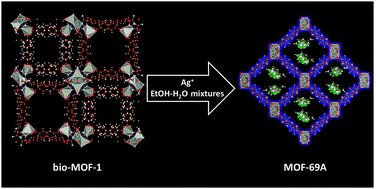Silver-induced reconstruction of an adeninate-based metal–organic framework for encapsulation of luminescent adenine-stabilized silver clusters†
Abstract
Bright luminescent silver-adenine species were successfully stabilized in the pores of the MOF-69A (zinc biphenyldicarboxylate) metal–organic framework, starting from the intrinsically blue luminescent bio-MOF-1 (zinc adeninate 4,4′-biphenyldicarboxylate). Bio-MOF-1 is transformed to the MOF-69A framework by selectively leaching structural adenine linkers from the original framework using silver nitrate solutions in aqueous ethanol. Simultaneously, bright blue-green luminescent silver-adenine clusters are formed inside the pores of the recrystallized MOF-69A matrix in high local concentrations. The structural transition and concurrent changes in optical properties were characterized using a range of structural, physicochemical and spectroscopic techniques (steady-state and time-resolved luminescence, quantum yield determination, fluorescence microscopy). The presented results open new avenues for exploring the use of MOFs containing luminescent silver clusters for solid-state lighting and sensor applications.


 Please wait while we load your content...
Please wait while we load your content...